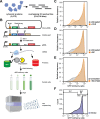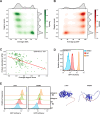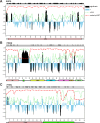This is a preprint.
A complete map of human cytosolic degrons and their relevance for disease
- PMID: 40463067
- PMCID: PMC12132302
- DOI: 10.1101/2025.05.10.653233
A complete map of human cytosolic degrons and their relevance for disease
Abstract
Degrons are short protein segments that target proteins for degradation via the ubiquitin-proteasome system and thus ensure timely removal of signaling proteins and clearance of misfolded proteins from the intracellular space. Here, we describe a systematic screen for degrons in the human cytosol. We determine degron potency of >200,000 different 30-residue tiles from more than 5,000 cytosolic human proteins with 99.7% coverage. In total, 19.1% of the tiles function as strong degrons, 30.4% as intermediate degrons, while 50.5% did not display degron properties. The vast majority of the degrons are dependent on the E1 ubiquitin-activating enzyme and the proteasome but independent of autophagy. The results reveal both known and novel degron motifs, both internal as well as at the C-terminus. Mapping the degrons onto protein structures, predicted by AlphaFold2, revealed that most of the degrons are located in buried regions, indicating that they only become active upon unfolding or misfolding. Training of a machine learning model allowed us to probe the degron properties further and predict the cellular abundance of missense variants that operate by forming degrons in exposed and disordered protein regions, thus providing a mechanism of pathogenicity for germline coding variants at such positions.
Keywords: DMS; E3; chaperone; deep mutational scanning; gene variants; proteasome; protein degradation; protein folding; protein quality control; protein stability; ubiquitin.
Conflict of interest statement
Competing interests K.L-L. holds stock options in and is a consultant for Peptone Ltd. All other authors declare no competing interests.
Figures






Similar articles
-
Systematic prediction of degrons and E3 ubiquitin ligase binding via deep learning.BMC Biol. 2022 Jul 14;20(1):162. doi: 10.1186/s12915-022-01364-6. BMC Biol. 2022. PMID: 35836176 Free PMC article.
-
HSP70-binding motifs function as protein quality control degrons.Cell Mol Life Sci. 2023 Jan 7;80(1):32. doi: 10.1007/s00018-022-04679-3. Cell Mol Life Sci. 2023. PMID: 36609589 Free PMC article.
-
Disease-linked mutations cause exposure of a protein quality control degron.Structure. 2022 Sep 1;30(9):1245-1253.e5. doi: 10.1016/j.str.2022.05.016. Epub 2022 Jun 13. Structure. 2022. PMID: 35700725
-
Tying up loose ends: the N-degron and C-degron pathways of protein degradation.Biochem Soc Trans. 2020 Aug 28;48(4):1557-1567. doi: 10.1042/BST20191094. Biochem Soc Trans. 2020. PMID: 32627813 Free PMC article. Review.
-
N-degron and C-degron pathways of protein degradation.Proc Natl Acad Sci U S A. 2019 Jan 8;116(2):358-366. doi: 10.1073/pnas.1816596116. Proc Natl Acad Sci U S A. 2019. PMID: 30622213 Free PMC article. Review.
References
-
- Hershko A, Ciechanover A. The ubiquitin system. Annu Rev Biochem. 1998;67:425–79. - PubMed
-
- Schimke RT, Doyle D. Control of enzyme levels in animal tissues. Annu Rev Biochem. 1970;39:929–76. - PubMed
-
- Eden E, Geva-Zatorsky N, Issaeva I, Cohen A, Dekel E, Danon T, et al. Proteome half-life dynamics in living human cells. Science. 2011;331(6018):764–8. - PubMed
Publication types
Grants and funding
LinkOut - more resources
Full Text Sources
